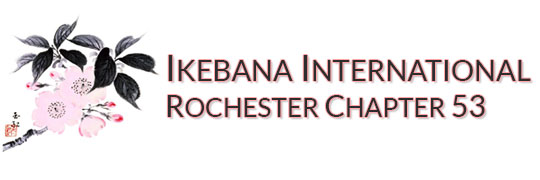Ichiyo School of Ikebana Iemoto Naohiro Kasuya Comes to Washington, DC.

Naohiro Kasuya is the Fourth Headmaster of the Ichiyo School of Ikebana, and therefore has the title of Iemoto. He came to Washington, DC the last week of July this year (2023) to participate in Otakon–the annual convention celebrating Asian pop culture.
The Ichiyo School of Ikebana Executive Master who lives in the Washington, DC area (Ms. Valerie Eccleston) had participated in the event the last several years and was so well-received that she suggested that the Iemoto consider exhibiting at one. He was excited about the idea so committed himself to come and exhibit at this year’s convention.
There was an estimated 40,000 attendees at the convention and many were excited to see this traditional Japanese artform on display at this convention celebrating modern pop culture.
The Iemoto took several days to prepare for the event after arriving in the Washington, DC area. And with the help of students of the Ichiyo School of Ikebana from the area and other states, multiple arrangements were set around the convention area. The largests of these is shown above.

The above picture is of an arrangement called a Hana-Byobu. “Hana” means flowers and “Byobu” means screen. So, together the term refers to a flower arrangement that uses a folding screen like frame for the flowers.
Here, the Iemoto on the left is flanked on his right with Kasumi, a Master in the Ichiyo School of Ikebana who lives in Okinawa and accompanies the Iemoto to help him for events like this. On the Iemoto’s left is Valerie Eccleston–the Executive Master who lives in the Washington, DC area and invited the Iemoto to exhibit ikebana at the Otakan event.
On the right of the picture are three students in the Ichiyo School of Ikebana. One came from the Washington, DC area, one came from the Ann Arbor, Michigan area and one from the Buffalo, New York area.
The arrangement is suspended by wires holding up the horizontal bamboo, the containers for water, and the ajiro folding screens. This arrangement was displayed outside the convention hall’s ballroom area.

Besides these larger arrangements show above, the Iemoto also make several “pop-up” arrangements. These smaller arrangements are created in a more spontaneous manner and placed in smaller places in high traffic areas that would not support a larger arrangement. The arrangement to the left includes the act of balancing the elements together besides the
beauty of the materials. This is one of the more common stylistic compositional characteristics of the Ichiyo School of Ikebana.
The other pop-up arrangement is actually a display of multiple arrangements. A hana-kazari is a flower display and in this picture to the right, there is a display of four flower arrangements. There is a flat form arrangement on the bottom with a moribana upright form on

the top shelf. Of course there is the basket arrangement and also the hanging arrangement on the post frame.

Taking a closer look at each arrangement in this display, we first see the hanging basket arrangement. These open-weave baskets are frequently used in the Ichiyo School of Ikebana arrangements. The open weave allows for the materials to come through the basket wall as opposed to being
blocked by them. We see this similar pattern in the large hanging hana-byobu arrangement above. However, the difference is that in the arrangement to the left, we are using a basket as opposed to the open-weave banner (ajiro) which can be wrapped around objects.
This hanging arrangement is a compound arrangement (two separate arrangements combined to make one arrangement). A piece of bamboo was cut in a way to have an upper and lower section that can hold water. A hole was drilled into the bamboo to allow for it

to be attached by placing it over a screw put into the wooden vertical frame. In these types of compound arrangements, some schools of ikebana will have the larger paired arrangement be the one on the bottom with the smaller one on the top. However, in the Ichiyo School of Ikebana, the larger paired arrangement is the one on the top.

This next arrangement is a “moribana upright” arrangement in which the flowers are arrangement in an upright fashion in a low-height basin. This type of arrangement is one of the first ones a beginning ikebana student learns in many schools of ikebana. It is basically an arrangement with three main stems and three flowers. However, this arrangement has some assistants being used to round out the arrangement, and the
main stems are flowers when they are many times branch material.
This last arrangement is considered a flat arrangement. It is similar to the moribana upright in that it classically has three main stems and three flowers also. However, it is broken up

with the largest stems being on one side (in this arrangement on the left) and the rest of the materials on the right. In this particular arrangement, there are more assistants than in the moribana arrangement above. This arrangement also has the addition of driftwood.
